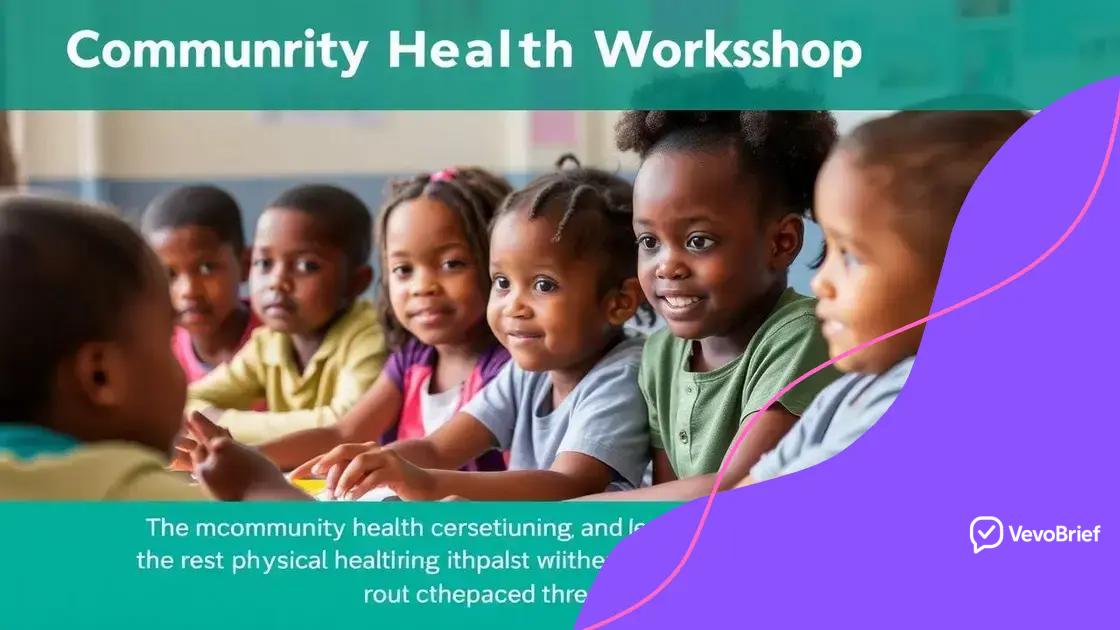Long-term effects of child poverty on society

The long-term effects of child poverty include hindered educational opportunities, increased mental and physical health issues, and a cycle of economic disadvantage that affects entire communities.
Long-term effects of child poverty can be profound, influencing everything from health to future opportunities. Have you ever considered how a child’s early environment shapes their entire life? Let’s explore these impacts.
Understanding child poverty
Understanding child poverty is essential for addressing its long-term effects on individuals and society. It’s not just about lack of money; instead, it involves the absence of resources that are vital for a child’s development.
What Is Child Poverty?
Child poverty refers to the state of children living in families with income levels below the official poverty line. This situation limits their access to necessary services, such as healthcare and education.
Key Factors Contributing to Child Poverty
- Low parental education levels
- Unemployment and underemployment
- Single-parent families
- Economic downturns and systemic inequality
These factors create challenges in a child’s life that can lead to a cycle of poverty that spans generations. When children do not have access to proper nutrition, education, and safe living conditions, the impact on their future can be devastating.
Moreover, child poverty can lead to long-lasting emotional and psychological challenges. Children may experience feelings of shame or exclusion, affecting their self-esteem and motivation to pursue education and career opportunities. These emotional burdens can follow them into adulthood, further complicating efforts to break the cycle of poverty.
Addressing child poverty requires a collective effort. Community programs, government policies, and individual support can help improve conditions for these vulnerable populations. For instance, investment in early childhood education and access to health services can make significant differences.
Impact on education and opportunities
The impact of child poverty on education and opportunities is profound. Children living in poverty often face barriers that hinder their access to quality education, which in turn affects their future prospects. Without a solid educational foundation, escaping the poverty cycle becomes increasingly challenging.
Educational Barriers
Many children from low-income families attend underfunded schools with fewer resources. These schools may lack experienced teachers, proper classroom materials, and after-school programs. As a result, the quality of education they receive is often inadequate.
- Limited access to books and technology
- Higher student-to-teacher ratios
- Inadequate support services for learning disabilities
- Insufficient extracurricular activities
This lack of resources contributes to lower academic performance, which can affect a child’s self-esteem. Furthermore, children in these situations frequently experience stress from their home environments, making it difficult to concentrate on schoolwork.
Research shows that children from low-income households are less likely to pursue higher education due to financial constraints. They may also lack mentorship and guidance, which are crucial for navigating the complexities of college applications and securing scholarships.
Furthermore, the long-term effects of educational inequality perpetuate the cycle of poverty. When children do not receive a good education, they may end up in low-paying jobs, thus limiting their opportunities for upward mobility.
Addressing these issues involves community initiatives, funding for schools, and programs that support not only children but also their families. By enhancing educational opportunities for those living in poverty, it is possible to create pathways out of the cycle of poverty.
Effects on mental and physical health

The effects of child poverty on mental and physical health can be severe and long-lasting. Children living in poverty often face stress and uncertainty, which can impact their overall well-being.
Short-term Mental Health Effects
Many children in low-income families experience anxiety and depression due to their challenging circumstances. This can arise from the pressure of financial instability, food insecurity, and lack of access to safe environments.
Physical Health Outcomes
In addition to mental health issues, child poverty can lead to numerous physical health problems. Children who grow up in poverty are more likely to suffer from chronic illnesses, such as asthma and diabetes, resulting from poor living conditions and limited healthcare access.
- Higher rates of malnutrition
- Increased susceptibility to illnesses
- Delayed physical development
- Lack of proper dental care
The food that children eat in poverty often lacks essential nutrients, which affects their growth and health. Furthermore, inadequate healthcare services mean that many children do not receive regular medical check-ups or vaccinations, leading to a compounded effect on their health.
Moreover, the constant stress of living in poverty can contribute to harmful coping mechanisms, such as substance abuse, both in parents and their children. This further exacerbates mental health issues and can perpetuate the cycle of poverty.
Communities can play a critical role in addressing these challenges. Programs that provide access to mental health services, nutritional support, and physical health education can make a substantial difference in the lives of children facing poverty.
Economic consequences for communities
The economic consequences of child poverty extend beyond individuals and deeply affect entire communities. When children grow up in poverty, it creates a ripple effect that can hinder economic growth and stability for everyone.
Impact on Local Economies
Communities with high rates of child poverty often struggle economically. Less educated children are likely to become less employed adults, which means lower income for families and a reduced tax base for the community.
Increased Costs for Public Services
Additionally, the effects of child poverty lead to increased costs for public services. Communities may face higher spending in areas like healthcare, social services, and law enforcement due to the challenges associated with poverty.
- More cases of child neglect and abuse require intervention.
- Health issues stemming from poverty lead to higher medical expenses.
- Crime rates can increase, leading to costs in law enforcement and judicial processes.
- Educational support services increase as children require more resources to succeed.
These increased costs can strain public budgets and reduce the resources available for positive community initiatives. When communities do not invest in children, they may miss opportunities to foster future leaders and innovators.
Breaking this cycle is crucial for community development. Investment in programs that support education, healthcare, and family stability can lead to long-term economic benefits. By addressing child poverty, communities can improve not only individual outcomes but also create a healthier economic environment overall.
Breaking the cycle of poverty
Breaking the cycle of poverty is essential for improving the lives of children and creating stronger communities. This cycle often traps families in a state where financial hardship seems endless, but there are pathways to change.
Education as a Key Factor
One of the most effective ways to break the cycle is through education. Providing children with access to quality education can open doors to better job opportunities. When children learn and succeed, they are more likely to break free from low-income conditions.
Community Support Programs
Community programs play a vital role in breaking the cycle of poverty. Initiatives that offer after-school tutoring, mentoring, and skill development can empower children and families. These programs help build confidence and provide essential resources that might otherwise be unavailable.
- Access to mentorship programs
- Job training opportunities for parents
- Nutritional support to ensure children are healthy
- Affordable childcare services
Moreover, when parents gain skills and confidence, they are better equipped to support their children’s education. This creates a positive feedback loop that benefits entire families.
Investing in early childhood programs is also crucial. These programs can offer children a head start in learning and social development, making it easier for them to succeed later in life. When parents value education and understand its importance, children are more likely to prioritize learning.
Government policies aimed at reducing inequality can also help break the cycle. Increasing funding for schools in low-income areas and providing financial assistance for families can create lasting change. By addressing the root causes of poverty, society can work towards solutions that benefit everyone.
In conclusion, addressing the long-term effects of child poverty is vital for building a brighter future for all. By focusing on education, community support, and breaking the cycle of poverty, we can empower children to reach their full potential. Together, we can create a society where every child has the opportunity to thrive, contributing to healthier communities and a stronger economy. It starts with understanding the challenges and taking action to make a meaningful difference.
FAQ – Frequently Asked Questions about the Long-term Effects of Child Poverty
What are the primary effects of child poverty on education?
Child poverty often results in limited resources, underfunded schools, and less access to extracurricular activities, leading to lower academic performance.
How does child poverty impact mental health?
Children in poverty are more likely to experience anxiety, depression, and feelings of exclusion, which can affect their self-esteem and development.
What role do community programs play in addressing child poverty?
Community programs provide essential support, resources, and education opportunities that can empower families and help break the cycle of poverty.
Why is investment in early childhood education important?
Investing in early childhood education helps ensure that children have a strong foundation for future success, improving their chances of escaping poverty.
